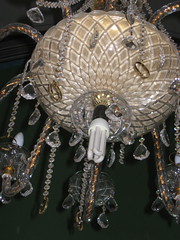You are here
Blogs
Words of Torah: Acharei Mot
On Saturday, April 16th, I offered the d'var Torah, literally, "words of Torah" in the alternative worship service at Congregation Agudas Achim in Austin, TX. In Jewish congregations, one portion (or parsha) is studied each week. The parsha for this week was Leviticus 16.1-18.30, and is called Acharei Mot. My words are below:
*****
In Austin: Interfaith Environmental Network
There were about 25 of us gathered on a Tuesday night in a synagogue in Austin, Texas: a handful of Baptists and Jews; a few Episcopalians; a couple of Methodists, Presbyterians and members of a Unity church; one Muslim; one Wiccan; one member of a Sufi order and one member of a non-denominational Christian church. Some were clergy, some volunteer and staff leaders in their religious communities, and some concerned laypeople. All were interested in learning more about how we can better work together to care for creation—people and the planet.
It was a good beginning.
All-Star Interfaith Eco-Justice League: Kosher Chili Cook-Off 2011
 Why would an interfaith environmental organization compete in a chili cook-off? Well, here are three good reasons:
Why would an interfaith environmental organization compete in a chili cook-off? Well, here are three good reasons:
1. It was a faith-based event—the 6th Annual Kosher Chili Cook-off in Austin, Texas, sponsored by Congregation Agudas Achim.
January 2011
Today, a little about me. Then as we go, I hope to hear from you—your comments, questions, hopes, ideas. We are, none of us, alone in this work of caring for creation, and the more we work together, the stronger and more effective we will be.
Lead Others to Join in your Energy Conservation Efforts
Involving Others Multiplies The Energy Savings Free July Webinars Show How to Spread the Energy-Efficiency Story Saving energy, saving money and saving the environment are all part of the energy-efficiency story. Most of us enjoy the advantages already and have implemented large or small energy saving programs in our homes, businesses and organizations. But, it's important to get others to follow in our footsteps, and ENERGY STAR ® wants to suggest ways you could help others.
Earn the ENERGY STAR for Your House of Worship
Congregations can sign up for EPA's Energy Star for Congregations training sessions, here.
What you can do Now, expanded tools available from EPA's ENERGY STAR Program make it possible to:
· Track energy use in your facility--even solar and wind
· Measure associated greenhouse gas emissions
· Set targets for investment priorities
· Track the results of your efforts
Energy Efficiency in the Holy Land
 As people of faith in Texas and around the United States celebrate Earth Day, TXIPL is happy to pass along one small example of action being taken in another part of the world as congregations work to combat global warming.
As people of faith in Texas and around the United States celebrate Earth Day, TXIPL is happy to pass along one small example of action being taken in another part of the world as congregations work to combat global warming.
In the ancient Middle-eastern city of Hebron, there is a large structure that holds a considerable amount of significance for Muslims, Christians, and Jews, as it sits over the supposed burial place of Abraham, Sarah, and other figures who played  central roles in the Abrahamic religions. On a recent trip to the site, which contains the historic Ibrahimi Mosque, I snapped these photos of the mosque's interior, which is lit by chandeliers using compact fluorescent light bulbs. (See below for more.)
central roles in the Abrahamic religions. On a recent trip to the site, which contains the historic Ibrahimi Mosque, I snapped these photos of the mosque's interior, which is lit by chandeliers using compact fluorescent light bulbs. (See below for more.)
Energy Future
The Dallas Business Journal recently published a short
article highlighting T. Boone Pickens' opinions about using gas and wind power.
Given the current national discussion about offshore drilling, energy
independence and the use of alternative energy sources, I thought many of you
would find it interesting.
Here is a link to the article.
Don't Have a Cow!
 Compact Fluorescent Light bulbs, or CFLs, have been touted as a way to greatly reduce our electricity consumption.
Compact Fluorescent Light bulbs, or CFLs, have been touted as a way to greatly reduce our electricity consumption.
Mercury in CFLs vs. Power Plants
There has been concern lately about mercury found in CFLs. While mercury is a concern, it is important to note that by using these bulbs, we are in fact helping to reduce our mercury output.
Currently, the amount of mercury released into our landfills from CFLs is negligible. Because of these bulbs’ long lifespan, only after 2010 will a majority of the CFLs currently in use need to be disposed of. At this time, it is estimated that roughly 80 to 100 million CFLs will be disposed of improperly. This number may sound considerable, but when you do the math, the amount of mercury in this large number of CFLs is only about 500 kilograms, or the

